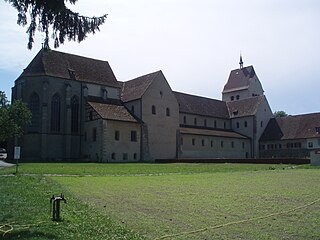Related Research Articles

Alcuin of York – also called Ealhwine, Alhwin, or Alchoin – was a scholar, clergyman, poet, and teacher from York, Northumbria. He was born around 735 and became the student of Archbishop Ecgbert at York. At the invitation of Charlemagne, he became a leading scholar and teacher at the Carolingian court, where he remained a figure in the 780s and 790s. Before that, he was also a court chancellor in Aachen. "The most learned man anywhere to be found", according to Einhard's Life of Charlemagne, he is considered among the most important intellectual architects of the Carolingian Renaissance. Among his pupils were many of the dominant intellectuals of the Carolingian era.

Fulda is a city in Hesse, Germany; it is located on the river Fulda and is the administrative seat of the Fulda district (Kreis). In 1990, the city hosted the 30th Hessentag state festival.

Rabanus Maurus Magnentius, also known as Hrabanus or Rhabanus, was a Frankish Benedictine monk, theologian, poet, encyclopedist and military writer who became archbishop of Mainz in East Francia. He was the author of the encyclopaedia De rerum naturis. He also wrote treatises on education and grammar and commentaries on the Bible. He was one of the most prominent teachers and writers of the Carolingian age, and was called "Praeceptor Germaniae", or "the teacher of Germany". In the most recent edition of the Roman Martyrology, his feast is given as 4 February and he is qualified as a Saint ('sanctus').

Walafrid, alternatively spelt Walahfrid, nicknamed Strabo, was an Alemannic Benedictine monk and theological writer who lived on Reichenau Island in southern Germany.

Ernst Ludwig Dümmler was a German historian.

Hucbald was a Benedictine monk active as a music theorist, poet, composer, teacher, and hagiographer. He was long associated with Saint-Amand Abbey, so is often known as Hucbald of St Amand. Deeply influenced by Boethius' De Institutione Musica, Hucbald's (De) Musica, formerly known as De harmonica institutione, aims to reconcile ancient Greek music theory and the contemporary practice of Gregorian chant with the use of many notated examples. Among the leading music theorists of the Carolingian era, he was likely a near contemporary of Aurelian of Réôme, the unknown author of the Musica enchiriadis, and the anonymous authors of other music theory texts Commemoratio brevis, Alia musica, and De modis.
Ermoldus Nigellus, or Niger—translated Ermold the Black, or Ermoald, was a poet who lived at the court of Pippin of Aquitaine, son of Frankish Emperor Louis I, and accompanied him on a campaign into Brittany in 824. Ermoldus was a cultured man with a knowledge of the Latin poets, and his poem, In honorem Hludovici imperatoris, has some historical value. It consists of four books and deals with the life and exploits of Louis from 781 to 826. He also wrote two poems in imitation of Ovid, which were addressed to Pippin.

St. Michael's Church in Fulda, Hesse, is considered to be the oldest replica of the Church of the Holy Sepulchre in Germany, built in the Carolingian architectural style (Pre-Romanesque) on behalf of abbot Eigil in the years. It served as a burial chapel to Fulda monastery founded in 744, which was one of the prominent cultural centres of the early Middle Ages. St. Michael stands in the neighbourhood of Fulda cathedral, and the architect was probably the monk Racholf. The rotunda and crypt remain preserved from this time. In the 10th and 11th century, the church was extended from the rotunda, and a west tower was built. In 1618 the roof over the rotunda was rebuilt with a conical roof, and in 1715 – 1716 a chapel was added to the north side. It was restored in 1853. Wall paintings in the interior date from the 11th century.
Leudesius was the son of Erchinoald, Mayor of the Palace of Neustria, and his wife Leutsinde.
Candidus (Bruun) of Fulda was a Benedictine scholar of the ninth-century Carolingian Renaissance, a student of Einhard, and author of the vita of his abbot at Fulda, Eigil.
Eigil was the fourth abbot of Fulda. He was the nephew and biographer of the abbey's founder and first abbot Saint Sturm. We know about Eigil primarily from the Latin Life that the monk and teacher of Fulda, Candidus Bruun composed about him after his death.
Smaragdus of Saint-Mihiel< OSB was a Benedictine monk of Saint-Mihiel Abbey near Verdun. He was a significant writer of homilies and commentaries.

The Abbey of Fulda, from 1221 the Princely Abbey of Fulda and from 1752 the Prince-Bishopric of Fulda, was a Benedictine abbey and ecclesiastical principality centered on Fulda, in the present-day German state of Hesse.
Sturm, also called Sturmius or Sturmi, was a disciple of Boniface and founder and first abbot of the Benedictine monastery and abbey of Fulda in 742 or 744. Sturm's tenure as abbot lasted from 747 until 779.
Wulfad was the archbishop of Bourges from 866 until his death. Prior to that, he was the abbot of Montier-en-Der and Soissons. He also served as a tutor to Carloman, a younger son of King Charles the Bald. Carloman succeeded Wulfad as abbot of Soissons in 860.

Wetti of Reichenau was a Benedictine monk, scholar and educator at the monastery at Reichenau in modern-day Germany. He was one of the leading educators of his time, and an influential scholar among monks and laity throughout not only the Carolingian empire but also the Western European monastic community. His best known surviving work is his biography of Saint Gallus, the founder of Reichenau's sister monastery, St Gall.
Max Manitius was a German medievalist and Latin scholar.
The Rythmus de captivitate Ludovici imperatoris is a short alphabetic acrostic poem in Middle Latin lamenting the capture of Louis II, King of Italy and Emperor of the Romans, on 15 August 871. The poem is preserved in a ninth-century manuscript, Veronensis XC (85).
Baturich, also spelled Baturic or Baturicus, was the abbot of Saint Emmeram's and bishop of Regensburg from 817 until his death.
Baugulf was a prominent Benedictine abbot in the Carolingian church. He was the second abbot of the Abbey of Fulda in present-day Germany. He served from 779 to 802 CE and was succeeded by Ratgar.
References
- ↑ Frassetto, M.; Jeep, J. M.; Smid, L. K. (2001). Medieval Germany: An Encyclopedia. Garland reference library of the humanities: Garland encyclopedias of the Middle Ages. Garland Pub. p. 258. ISBN 978-0-8240-7644-3 . Retrieved June 13, 2018.
- ↑ Kambaskovic, D. (2014). Conjunctions of Mind, Soul and Body from Plato to the Enlightenment. Studies in the History of Philosophy of Mind. Springer Netherlands. p. 192. ISBN 978-94-017-9072-7 . Retrieved June 13, 2018.
- 1 2 3 Hraban Maur in Monum. German. Histor.: Poetaes Latini Aevi CarolingiII, poem 13.
- ↑ Annales Fuldenses in "Monum. German. Histor.: Scriptores 1, p. 353.
- ↑ Alcuin, Intercessio Albini Pro Mauro, in Monum. German. Histor.: Poetae Latini II, p. 160.
- 1 2 Introduction to Candidus' Life of Eigil, Patrologia Latina 105, col. 383.
- ↑ Hraban Maur in Monum. German. Histor.: Poetaes Latini Aevi CarolingiII, poem 30.
- 1 2 Candidus Bruun, Vita Aeigili, in E. Duemmeler, ed. Monum. German. Histor.: Poetae Latini Aevi Carolini II (Berlin, 1884), pp. 94-117.
- ↑ Dümmler, E.; Monum. German. Histor. (München); Traube, L.; von Winterfeld, P. (1884). Monum. German. Histor.: Poetae Latini aevi Carolini, t. 2. Weidmann. p. 100. Retrieved June 13, 2018.
- 1 2 Annales Fuldenses in Monum. German. Histor.: Scriptores 1, p. 356.
- ↑ Dümmler, E.; Monumenta Germaniae Historica (München); Traube, L.; von Winterfeld, P. (1884). Monumenta Germaniae historica: Poetae Latini aevi Carolini, t. 2. Weidmann. p. 101. Retrieved June 13, 2018.